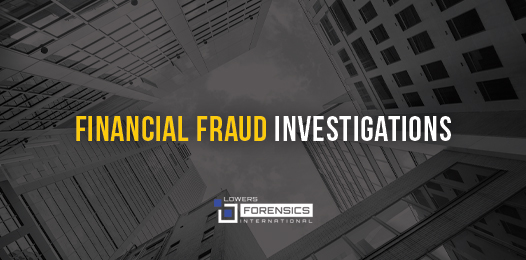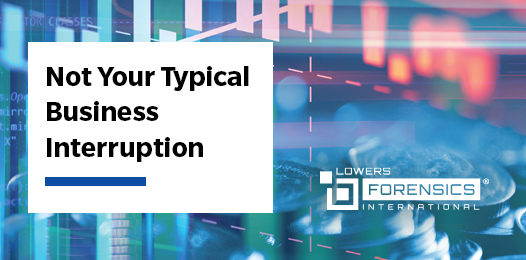Over a span of 11 years, two California agricultural businesses were allegedly impacted by an embezzlement scheme perpetrated by their trusted bookkeeper, losing approximately $5 million. Losses could have been far less had it not taken 11 years for the alleged crime to be uncovered. Yet, open any newspaper and you will commonly find stories of companies being victimized by fraudsters from within and outside the organization.
When an employer suspects occupational fraud (defined as fraud perpetrated by an employee) and/or files a claim with their insurer, that insurance company often turns to a forensic accountant to get to the bottom of the matter. We spoke with Megan Johnson, Senior Manager at Lowers Forensics International, to understand the elements of a successful financial fraud investigation. Johnson broke it down into five keys:
1. Gathering Background Information
In a recent case, Johnson says an employee for a retail operation with multiple locations was accused of allegedly skimming funds from the company. As the only accounting person in the administrative office, the individual was responsible for virtually all aspects of recordkeeping, from writing checks to reconciling accounts and processing payroll.
In order to fully understand what happened, forensic accountants will attempt to gather as much information as they can upfront. They seek to get the whole picture and confirm how the scheme was carried out. Usually, they’ll start by speaking to the insurance adjuster to get basic details about the claim. They’ll also review internal controls, collect relevant documentation, such as financial statements or employment files, and ask questions of other staff, vendors, and customers.
In the case of the retail operation, an obvious and important piece of background information was the lack of oversight and internal controls, specifically the segregation of duties.
In an ideal scenario, the forensic accountant interviews the alleged employee directly, but Johnson adds that most often they won’t grant such conversations due to the ongoing investigation and risk of being found liable for the financial debt.
2. Knowing the Systems Involved
Skillful forensic accountants will have a good working knowledge of all of the major accounting software platforms and their accompanying loopholes. For example, the accounting platform used in this case allowed the user to input the name of one vendor into the software but altered that vendor name before the check was printed.
“It’s also helpful to think like a criminal,” Johnson says. “If I wanted to cover my tracks and hide evidence of my activities, how would I do it?” Those tricks might include changing names on checks, charging expenses to general line items (e.g., cost of goods sold), or reconciling accounts before anyone else sees the bank statements.
3. Obtaining Complete Documentation
Most organizations are more than happy to share any and all documentation they have in an effort to recoup their financials losses, determine how the theft was achieved and how to avoid potential future losses.
In other cases, employers may be reluctant to provide complete access to their records for fear of appearing culpable by maintaining no oversight of the employee and the “red flags” that were not further investigated at the time. For example, issuing back to back loans to the alleged employee to pay delinquent debt for years prior to the discovery of the potential fraud. “At first, this employer was hesitant to turn over their full financial statements, but once they did, it was easy to link the pieces together,” notes Johnson. She continued, “The bank statements tied to the cleared checks which were made payable to the accused employee where the general ledger noted a different payee and was identified as a business expense. The employee had a very consistent and recognizable pattern in terms of the way the timing of the fraudulent checks were written.”
4. Understanding Job Functions
Many small businesses lack the financial resources or simply the awareness of what it means to have good internal financial controls. In the retail scenario presented earlier, there was no segregation of duties. The employee who wrote the checks was also responsible for reconciling accounts, reviewing invoices, paying the bills and processing payroll. This individual even had a rubber stamp with the owner’s signature. No one was overseeing the work, and the individual was basically in charge of all things financial.
Johnson explains that most employees don’t go in with the intention of stealing from their employer, but when an opportunity presents itself, or the employee is falling on hard times (a “red flag” for fraud), sometimes they choose to take that step thinking they’ll do it just this one time, no one will know and I’ll pay it back when I can. In this case, the accused was a trusted employee who had been with the company for 10 years and was like family but had recently been faced with collections on several overdue loans.
Employee Red Flags That Can Lead to Fraud
The Association of Certified Fraud Examiners points to several red flags of occupational fraud. These include:
- Living beyond one’s means
- Financial difficulties
- An unusually close relationship with vendor/customer
- Control issues, unwillingness to share duties
- Divorce/family problems
- “Wheeler-dealer” attitude
- Unwillingness to take time off
5. Following up on Internal Controls
Once an investigation has been concluded, a reputable financial forensics firm will work with the employer to implement internal controls to thwart future losses or potential theft by employees. These measures include such controls such as clear separation of duties, an audit department, diligent hiring practices, external audits, job rotation, and data monitoring technologies. A strong code of ethics and anti-fraud policies will also go a long way in preventing and detecting fraud.
At the end of the day, there is always a possibility an employee will steal from their employer and a resulting insurance claim will be filed. If you find yourself in this unfortunate circumstance and would like the guidance of a trusted forensic accountant to sort through the details, please contact us for a no-obligation conversation.





